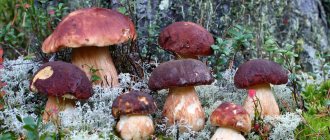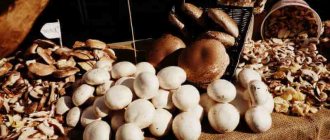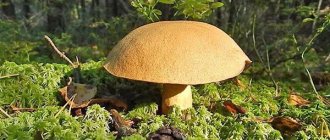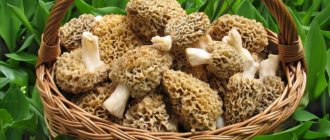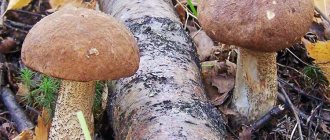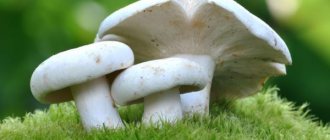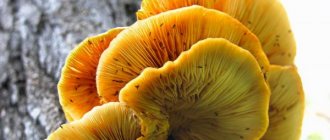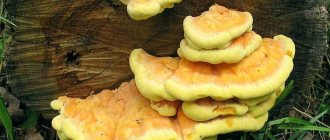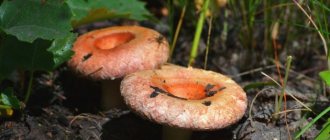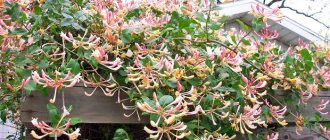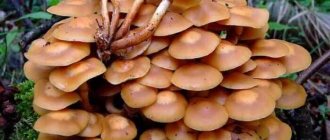The umbrella mushroom, photo and description of which are presented in this article, is one of the most delicious mushrooms; it is a type of champignon, although it differs in appearance and taste (it has a pleasant nutty taste). The edible umbrella mushroom belongs to the group of saprophytes (growing on decomposing organic debris).
There are 5 varieties growing in Russia. Beginning mushroom pickers do not collect umbrellas, as they look like fly agarics. However, experienced lovers of “silent hunting” are happy to put young umbrellas, which always grow in one place, in their basket. Next, we’ll talk about how to distinguish it from its poisonous counterparts , where it grows and how to prepare such real umbrellas.
Important! The umbrella mushroom absorbs all substances from the soil, so it can only be collected in ecologically clean areas, farther from highways and industrial enterprises. If collected in contaminated areas, even edible species can cause poisoning.
Umbrella mushroom - description
The umbrella mushroom or, as it is called, large lepiota, belongs to the macrolepiota. This is a whole department of the champignon family. The mushroom got its name not by chance, but due to its specific appearance. Mushrooms are classified as edible. Class Agaricomycetes. Order agaricaceae.
The Latin name (Macrolepiota procera) was derived from the ancient Greek “macro”. It means "big".
hat
Depending on the location and growing conditions, the cap of this mushroom can have either an ovoid or a hemisphere shape. The older the umbrella is, the flatter and wider the cap becomes.
If you evaluate its structure, then at a young age it is thin and fleshy. At a more advanced age, the cap thickens.
In the very center there is a small pointed tubercle of a round shape. The cap, again, depending on the age and growing conditions of the mushroom, can have all shades of brown. The young mushroom is white, with small brown spots.
As a rule, the darkest part is concentrated precisely in the center on the tubercle. And gradually, the dark shade spreads from the center to the edges. The skin has a scaly structure and can crack under the rays of bright sun.
Leg
The stem of the mushroom is thin, somewhat reminiscent of the stem of a fly agaric. It has a cylindrical shape. The base is presented in the form of a tuber, dense and fibrous in structure. The stem is also easily separated into fibers and easily detaches from the cap. In older mushrooms, a kind of skirt forms under the cap at a distance of several centimeters. This indicates the age of the mushroom.
Pulp
When young, the umbrella is not fleshy, so there is practically no pulp in it. It breaks down quickly and has virtually no taste. The older mushroom is fleshy, the insides are white. However, if the cut is left in the air for a few minutes, it will take on a yellowish-brown tint.
The mushroom pulp is aromatic and juicy. Does not deform when frying or cooking.
Edibility
Mushrooms are edible, so after proper processing they can be used as food. The main thing is to clear the scales. And after that, you can use it in culinary experiments. The legs of this mushroom are quite fibrous and tough, so they are eaten very rarely.
The caps have good taste, somewhat reminiscent of champignons.
The mushroom is especially common in French recipes. It can be fried in vegetable oil, baked with herbs and added to pancakes. The caps are first rolled in flour or breadcrumbs, and then in the egg. Thus, a whole baking sheet of umbrellas is baked in the oven with garlic sauce.
Important! But it’s worth noting that you won’t be able to feed your guests with mushrooms and umbrellas. During the heat treatment process, the umbrellas become very fried and are served more as an addition to the main dish.
In its fresh form, large lepiota is used in the preparation of soups. You can also try to marinate mushrooms, use them as an addition to sandwiches or salads.
a brief description of
Edible mushrooms are considered a delicacy because... They have tasty and tender pulp, as well as an amazing aroma.
They received their name as a result of a combination of two Greek words - macro, which means “big”, and lepiota - “umbrella”. The fruiting body with an elongated stem and dome-shaped head looks like an open umbrella.
The description includes several distinctive qualities:
- standard structure, medium or large size, circumference 35-40 cm
- at a young age the cap is ovoid or hemispherical, in adult specimens it is expanded, convex-flattened, like a dome;
- the surface is white with a pronounced tubercle in the center; as it grows, it cracks, forming numerous scales of a light brown tone;
- the leg is erect, sometimes slightly curved, cylindrical, easily separated from the cap, tuberous at the bottom;
- in cross-section, the fruit body is fleshy, dense, and darkens when broken;
- the plates are light, densely spaced, and turn brown with age;
- in the middle the leg is ringed with a white border with corrugated edges; in adult specimens this part is multilayered.
Umbrella mushrooms are characterized by the presence of a special formation - a collarium (ring-shaped thickening), which is formed due to the fusion of the edges of the free plates of the hymenophore around the stalk.
():
- Umbrella mushrooms are saprophytes and settle on the soil both in the forest and beyond. Although they are not mycorrhiza-formers, they are found in the same place year after year. Although all of them are edible, some representatives of the genus are very highly valued in the markets of Europe, Asia and Africa, especially the variegated umbrella mushroom.
- Macrolepiotes are cosmopolitan and distributed almost throughout the globe. The best studied species are those of the northern temperate zone.
- It is known that the mycelium of most mushrooms develops without access to light, but the need for cap mushrooms to form full-fledged fruiting bodies is very different. In the complete absence of light or its excess, fruiting may not occur at all, or the formation of ugly fruiting bodies that are not capable of forming spores will occur.
They grow in different climatic conditions and are distributed almost everywhere - in America, Asia, Africa, Australia, Mexico. In our country they prefer to grow in regions with a temperate climate. The collection is carried out in the summer-autumn period.
Where and when to collect variegated umbrella?
These cute umbrellas grow in the wooded part of Central Russia. They can be found in plantings and deciduous forests. Mushrooms prefer edges and places with diffused sunlight. But they cannot stand dark areas of forests and thickets. You can often find them along clearings, in clearings and meadows with tall grass.
But mushrooms are found not only in Russia. They are distributed throughout the continent of the European Hemisphere, and are found almost everywhere except the northern regions.
The mushroom is common in Asia and Africa.
Found in abundance in Canada.
When to go hunting for large lepiota?
The collection season begins in mid-June. At this time, the first representatives of umbrellas appear. The season lasts until the end of October. At this time, you can already find large mushrooms.
Time and place of fruiting
The variegated umbrella is a saprotroph and prefers sandy soils, light areas, clearings and forest edges. It can often be found in clearings and clearings, as well as in parks, on the grass, in the garden and in the field.
It is most widespread in the north of the temperate zone. It is most often found in Europe, Turkey, Iran, Kyrgyzstan and Mongolia. Distributed in Siberia and the Far East. Can be found in Japan, North and South America, Australia. Even on islands such as Cuba, Madagascar and Sri Lanka, this mushroom is collected.
Fruiting time occurs from June to November, often found singly, sometimes in small groups that form “witch circles.”
Video
Benefits for the body
Large lepiota has excellent taste. That is why many mushroom pickers purposefully go for it. It is better to collect and use mushrooms when they are young. Only in this case they contain a huge amount of vitamins and nutrients. They are preserved even after heat treatment. The properties are preserved after marinade, salting and drying.
What substances does the umbrella mushroom contain?
- B vitamins.
- Vitamin C.
- Vitamin E.
- Vitamin K
- Tyrosine.
- Beta glucans.
- Potassium.
- Calcium.
- Magnesium.
- Phosphorus.
- Iron.
- Sodium.
- Melanin.
That is why, in ancient times, local healers actively used lepiota majora to prepare tinctures and extracts in order to eliminate serious ailments. Indeed, the mushroom helps fight the following types of diseases:
- oncology;
- rheumatism;
- diseases of the heart and blood vessels;
- various nervous system disorders.
How to use mushroom to benefit your health?
Yes, this is what you need to know, how to make a tincture recipe.
It can be used in the treatment of diseases, as well as for general strengthening of the body and boosting immunity.
For cooking you will need 700 g of mushrooms.
- They need to be washed well, dried and finely chopped.
- Then take 500 ml of vodka.
- Pour liquid over mushrooms.
- If necessary, add a few small capsicums.
- Store the tincture in a cool, dark place for 2-3 weeks.
- After this time, it can be actively used.
For example, do rubbing, massage, and also add to food.
Of course, such treatment methods can only be carried out if you are sure that such therapy is not contraindicated for you.
Might be interesting - Dung beetle mushroom (Coprinus): description of 6 species with photos, an effective remedy for alcoholism.
Evaluation of taste qualities, medicinal properties, benefits and possible harm
Many mushroom pickers rightfully consider the motley umbrella one of the most delicious gifts of the forest. Young specimens are especially good when roasted on a grill or over a fire. This fruit is even consumed raw in salads or sandwiches. The stems are tougher than the caps; they are often used dried; they are especially tasty as a seasoning with a bright mushroom aroma. The oldest specimens can be fermented.
Attention! Motley umbrellas should not be given to children under 7 years of age, pregnant or lactating women. Use with caution if you have allergies, gastrointestinal, liver or kidney diseases.
The variegated umbrella has a beneficial effect on many functions of the body, it is capable of:
- improve the functioning of the cardiovascular system;
- have an anti-cellulite effect due to the high content of potassium and copper;
- increase the body's resistance to infectious diseases;
- help fight cancer;
- stimulate the immune system;
- maintain mental activity;
- fight stress and fatigue;
- normalize metabolism;
- get rid of cholesterol;
- normalize the functioning of the thyroid gland;
- overcome excess weight.
Contraindications for the variegated umbrella
Not everyone will benefit from eating lepiota major. There is a whole list of contraindications that you need to listen to before collecting umbrellas.
- It is contraindicated to use the mushroom in any form for diseases of the gastrointestinal tract.
- Prohibited for use by pregnant women.
- Nursing mothers.
- For pancreatitis.
- Children under 5 years of age.
Important! Even if you do not consider yourself a risk group, still refuse to consume umbrellas that you have collected along roads, near industrial zones or near landfills.
What is Macrolepiota procera confused with?
The variegated umbrella mushroom is very often confused with its poisonous counterpart. Therefore, mushroom pickers should know how to distinguish these two species.
Lepiota poisonous
Poisonous lepiota is a very dangerous mushroom that can cause significant damage to your body. Its main difference from the motley one is that it is much smaller in size. The hat has a diameter of less than 6 cm. Take a close look at it. The cap should have a pinkish tint, and the cut flesh should also have a pink tint.
Amanita stinking
Another similar mushroom is the stinking fly agaric. It is also poisonous and hazardous to health. The caps of these mushrooms are similar, however, fly agaric grows only in shady forests with high humidity. At the same time, the base of its leg has a free vulva, which is clearly visible. The fly agaric cap is covered with flakes and has a glossy shine.
Elegant
Another brother is the elegant umbrella mushroom. It is not poisonous, so it can also find a place in your basket. It is distinguished by a long thin leg. Unlike the variegated mushroom, which stands on a white stalk, the stalk of the graceful one has a brown tint with white splashes.
Mastoid
Mastoid umbrella mushroom. Edible variety. Its cap can reach a diameter of up to 12 cm. Regardless of age, it is thin and not fleshy. It has a slightly bell-shaped shape, rounded at the edges. The younger the mushroom, the more bell-shaped it takes. At an older age, the cap becomes wide and evenly distributed, and has an umbrella shape.
In the center you can see a small pointed tubercle. The edges of the mushroom are thin, rolled inward. The skin, like its predecessor, has a whitish tint. The center is a little darker than the edges. With age, the scales on the cap become more and more numerous.
The pulp has a dense consistency and a white tint. When cut, its color does not change and remains white.
The mushroom tastes like hazelnuts and has a corresponding aroma. The leg reaches a height of 16 cm, slender and not thick, about 5 mm in diameter. The leg has a brownish-white tint. This mushroom is also found in Central Russia, South America, Asia and Australia. Less common in North Africa.
Conrad
Conrad's umbrella mushroom. Another edible representative of the family. The hat has a diameter of 12 cm. It is very thick at the center and thinner at the edges. It has an ovoid shape. Some people call it the bell mushroom. In adulthood, the cap becomes more convex. In the center, just like its predecessors, there is a tubercle.
The skin has a dirty gray tint with brown patches. The center is much darker than the edges. The flesh of the cap is white. The color of the cut does not change. The smell is delicious, pleasant. The leg reaches 15 cm in height. Quite thick, about one and a half cm in diameter. It has a cylindrical shape. Thin at the cap and widens towards the base. The surface has a brown tint.
The mushroom inhabits coniferous areas and mixed forests. Distributed in Europe and Asia.
Difference between false twins and poisonous toadstools
When collecting mushrooms, it is very important to learn to distinguish edible specimens from poisonous ones.
| Name | Appearance | Pulp | Danger |
| Macrolepiote procera | The surface is covered with brown scales, large in size. | White, color does not change | Edible |
| Elegant umbrella | The cap is covered with yellowish scales, the edges are often cracked, smaller in size | White, does not change when cut | Edible |
| Shaggy mushroom | Beige hat, covered with matching scales, not large in size | White, red-brown when cut, especially visible on the stem | Edible, but may cause mild poisoning and allergies |
| Morgan's umbrella | In ripe fruits, the cap is depressed in the center, with brown scales | White, turns red-brown when pressed | Highly poisonous |
| Chlorophyllum lead-slag | The white cap is covered with pink-brown remains of the spathe | White, does not change color, but may in some cases acquire a red tint | Inedible |
| Chlorophyllum dark brown | Light cap with brown scales | White, turns orange when cut | Poisonous mushroom |
Important! The most important difference between the motley umbrella is its size. He does not have such large doubles. Only young fruits can be confused, but all of them change the color of the flesh when pressed or cut.
Cooking recipes
There are a lot of delicious and healthy recipes, the ingredients of which will be umbrella mushroom.
Breaded mushrooms
- You will need 500 g of mushrooms.
- Two eggs.
- Onions 2 pieces.
- Three tablespoons of flour.
- Hard cheese 300 g.
- A little vegetable oil, salt, ground black pepper.
- A bunch of parsley and dill.
First, prepare the mushrooms. Remove the stems and clean and rinse the caps well.
Beat eggs and flour until smooth. Season well with salt and pepper. Finely chop the onion.
Place mushrooms on a baking sheet and sprinkle with onions. Pour flour and eggs on top. Sprinkle with hard cheese and then place in the oven for 30 minutes at 200 degrees. Wait for the cheese to melt. Stewed mushrooms need to be decorated with herbs.
Mushroom caviar
When prepared correctly, caviar turns out to be very tasty. To prepare it you will need:
- 1 kg of mushrooms;
- 4 onions;
- vegetable oil;
- lemon juice in the amount of 40 ml;
- garlic;
- salt;
- sour cream 100 ml;
- 2 tablespoons of tomato paste.
Peel the mushrooms, finely chop the onion and fry in a frying pan.
Then add the mushrooms to the frying pan and fry until the onions acquire a golden hue. After this, add sour cream and simmer for about 10 minutes over low heat. Mix everything well, add salt, pepper and other favorite spices.
Simmer for 20 minutes. Season the resulting caviar with tomato paste in the specified amount. Serve spread on baguette or toast.
Umbrella mushrooms in the microwave
If you are hungry, umbrella mushrooms can be cooked very quickly in the microwave.
- To do this, separate the caps from the legs. You don't need legs.
- Add 200 ml mayonnaise.
- Season with black pepper and salt.
- Add coriander and a pinch of nutmeg.
- Mushrooms must be pre-prepared and marinated in the specified mixture. Leave for 30 minutes.
- Later, place the mushrooms on a plate, cover with a lid and microwave for 15 minutes.
The dish must be hot when served. It is recommended to decorate it with dill and parsley.
Umbrella stuffing
The French love to use this mushroom as a filling for buns, croissants or pancakes. But in order to prepare a truly delicious filling, you need to follow the recipe.
You will need 500 g of mushrooms.
- They need to be washed and cleaned well.
- The stem is separated from the cap.
- All mushrooms must be finely chopped with a knife to obtain a brown mass.
- Finely chop onion, garlic, and herbs. It is recommended to use basil, parsley, dill, and oregano.
- All ingredients are prepared. Place the frying pan on the fire, heat the vegetable oil.
- First, add the onion. Fry it until golden brown.
- Next, add the mushrooms. Fry together with the onion for a short time, just a couple of minutes.
- Then add finely chopped herbs and garlic.
- Fry everything together for a few more minutes.
- Then take heavy cream. Carefully pour in approximately 80 ml.
- Continue stirring the resulting mass.
- Then, add some dry white wine. Approximately 30-40 ml.
- Continue to simmer. At the very end, add salt and pepper to taste, as well as other favorite seasonings.
Before adding the filling to pancakes or buns, it must be well cooled.
The cool filling will have a slightly nutty aroma and goes well with the airy yeast dough.
If you want to stuff pancakes, you can add fried minced chicken to this mixture. It turns out very tasty, and most importantly, interesting. New line with
Cream can be replaced with full-fat sour cream. It is possible to achieve the same effect.
How to distinguish from dangerous and inedible
Among the general diversity, there are similar poisonous counterparts of the genus Lepiota, belonging to the same family Agaricaceae (Champignonaceae) as representatives of the genus Macrolepiot (umbrella mushroom).
():
The genus Lepiot is close to the genus Macrolepiot, but differs from it in the following features:
- Slightly smaller fruiting bodies (cap diameter is about 2-10 cm, very rarely 13 cm).
- The presence of a fixed ring on the leg.
- The presence on the surface of the cap of scales of a characteristic mica-like or fibrous consistency.
- Absence of germ pores on spores (discovered by microscopic examination).
- Like macrolepiotes, representatives of lepiotes are cosmopolitan, but their individual species have a somewhat more limited distribution in a certain temperature zone (Central and South America). Temperate zones are poor in species of the genus: it prefers hot, tropical and subtropical zones.
Lepiots are saprophytes on soil and plant debris. They are found on forest soil, grassland, living and dead trees, treated wood, straw, dead fern stems and dead palm fronds.
After reading their description, you can easily distinguish them from edible umbrellas.
Comb
Silverfish, or lepiota comb, is an inedible, sometimes even dangerous species. In the post-Soviet space, it is one of the widespread inedible suspicious species, which is noted as poisonous in Western European profile guides.
Characteristic features:
- the upper part is small - from 2 to 5 cm;
- young specimens are bell-shaped, adults are convex-prostrate, with a pointed tip;
- brick color with ocher or orange scales;
- the leg is thin: length up to 8 cm, thickness 0.5 cm, erect, widened at the bottom, hollow, comes in two tones - yellowish or beige with a whitish or pinkish narrow ring (in young ones), covered with a powdery coating. In adult mushrooms there is no ring;
- the pulp consists of fibers, exudes a pungent, unpleasant rare odor, tastes unpleasant, and turns red when touched.
The scaly species lives in the northern zone with a temperate climate. Fruiting bodies are found from June to October.
Chestnut
The mushroom has poisonous counterparts
The second name is chestnut umbrella. This false double has a small cap size - 2-4 cm, the surface is reddish-brown or chestnut.
The caps of young mushrooms are ovoid, while those of adults are flat. The older the mushroom, the more dark brown cracks there are at its top. When cut open, the fruit body is white, brittle, and emits a pleasant odor.
The leg is a cylinder, contains pubescence at the base. It is red-brown inside and has a narrow whitish ring on the surface. The plates are thin, initially snow-white, and darken with age. The ring is white, narrow. Its presence indicates the young age of the mushroom. It is absent in adult fruiting bodies.
Poisonous chestnut twins are found in Europe, Western and Eastern Siberia in regions with a temperate climate.
Rough (sharp-scaled)
Rough umbrellas are considered inedible. The cap size is 7-15 cm, the color is olive or red. At an early age, the mushrooms have an oval-shaped cap, while at a mature age it is spread out, densely covered with rust-colored scales.
The plates are thick, loose, whitish. When pressed and as the fruiting body matures, they become brown.
The leg is long - 7-12 cm, thickness - 1-2 cm, cylindrical with a swollen base. The color is light yellow with barely noticeable white stripes. This species is characterized by the presence of a large ring on the stalk, which persists throughout the life of the fruiting body. On the underside of the ring there are brownish warts.
The pulp is bitter, pungent, and emits an unpleasant odor.
Inedible umbrella mushrooms are found in Africa, Europe and North America. Fruiting lasts from August to October. Found in mixed forests.
Lead slag chlorophyllum
This is a very poisonous mushroom with a spherical, later flat, snow-white cap, covered with pink or chestnut scales left over from the coverlet. The diameter of the cap increases with age - from 8 to 30 cm.
The leg is erect, with a smooth surface, measuring 10-25x1-3 cm, white, turning brown in places of pressure, in the upper part there is a large, often movable ring.
The inside of the fruit body is white, turns red when broken, without any taste or smell.
White plates are densely located under the cap, later acquiring an olive or greenish-gray tint. After injury they turn brown.
If it gets into food, it can cause serious poisoning and even death. In some reference books it is called "Lepiot Morgana". Grows on soil in open places, less often in forests, singly or in groups.
For your information. In the places where it grows, Chlorophyllum lead-slag is often confused with the edible variegated umbrella mushroom. As an additional diagnostic feature that allows specialists to distinguish between these species, a specific reaction can be used, in which the spores of a poisonous mushroom are not stained with a saturated solution of Congo red dye in NH4OH mixed with a 5% KOH solution, in contrast to the spores of the variegated umbrella mushroom, which acquire yellow color.
These twins grow mainly in Eurasian countries, the USA, Africa and Australia.
Dark brown chlorophyllum
- The fruit body is large, the entire surface is covered with scales, girth 10-15 cm;
- The cylinder leg is initially whitish, later becomes brownish-gray, thickened and practically invisible;
- A tuber growth with a diameter of 6-7 cm is formed in the base area;
- The pulp is snow-white; when broken, it first turns orange, then turns slightly red.
This type of “umbrella” is considered hallucinogenic: the mushroom contains strong toxic substances. Distributed in the Czech Republic, Hungary, USA and Slovakia.
By the way. The small genus Chlorophyllum is very close to the genus Lepiota and differs from it in the greenish color of the spores of the lamellar hymenophore.
Panther fly agaric
Fly agaric poisoning can cause death
It is a poisonous variety and can be fatal if poisoned.
It can be distinguished by the following characteristics:
- the cap is of different shades of brown (brown, black-brown, yellow-brown, etc.), glossy, covered with white scales - the remains of the bedspread, hemispherical, with a diameter of 4-12 cm;
- the leg is long - up to 12 cm, thin - 1-1.5 cm, widened in the lower part, ringed;
- snow-white plates with brown elements;
- when cut, the fruit body is whitish, does not change color when broken, smelly with a sweetish taste;
- vagina (volva) - adherent.
Habitat: regions and countries with temperate and harsh climates. The alkaloid hyoscyamine, similar in structure to atropine, was found in its tissues.
Amanita stinking (white toadstool)
This is one of the most toxic poisonous mushrooms, with poisoning from which in most cases a person dies.
The cap of this large poisonous mushroom is white, with a slight yellowish tint towards the top. Almost always without scales. Young mushrooms have a conical shape, while adults have a slightly convex shape.
The size of the white cylindrical stem is 10-15x1-2 cm, in the lower part it is tuberous, in young specimens it has a filmy ring under the cap itself.
When cut, the mushrooms are white, they are very smelly with a smell somewhat reminiscent of bleach. This is especially noticeable in mushrooms that have lain a little.
The species is considered to be as deadly poisonous as the pale grebe.
Distribution: mountainous regions of Central and Southern Europe, the Far East and Northern France.
Breeding and growing umbrella mushroom
As we found out earlier, the umbrella mushroom belongs to the champignons. But unlike its counterparts, it is still difficult to domesticate.
You can try to grow an umbrella mushroom in your garden. Choose a shady but not too dark place in the garden.
The umbrella mushroom can be spread in two ways. Through the mycelium (by digging up the rhizome) and moving it to the place you need. Or spores that appear in the mushroom cap.
It is recommended to resort to the first method, because only in this case can you count on a positive result in 90% of cases.
The mycelium is dug out in the forest very carefully; it cannot be damaged.
In order for the mycelium to live in a new place, it is desirable that the composition and structure of the soil be similar.
Place the mycelium in the prepared depression and spray well with water. Make sure that no one digs up the mycelium at first. Also protect from excessive rainfall. This procedure is best performed in early spring.
Reproduction by spores in the garden is a rather thankless process. Mushrooms may not like everything, from the composition of the soil to the chosen location. Therefore, when doing such a procedure, be prepared in advance for the fact that you may not achieve an effect.
However, it's still worth a try.
What to do in this case? You need to select several mushroom caps. It is desirable that they be large and as mature as possible. Worthy damaged caps will also work.
Carefully thread a thread through them and hang them above the ground at a distance of about 10-15 cm. To do this, you can make special structures or use trees or shrubs growing nearby.
The place intended for mushrooms must first be cleaned, if possible fertilized and spilled with water.
The mushrooms remain in this form for as long as possible. This is necessary for the spores to fall to the ground. Only 10-20% of them will sprout, provided the soil is suitable.
However, even if the fungus takes root, it can freeze at almost any moment due to a lack of the substances it needs.
You can also plant an umbrella mushroom in the forest. Keep in mind that lepiota is very picky, so it most likely will not take root in your garden.
For breeding you will need old worm caps. They need to be carefully hung over the place where they were once cut. This way you can imitate the process of natural reproduction.
The mushroom will sprout spores and some will sprout. Gradually you can increase the radius of spread by hanging mushrooms further and further.
Collection rules
When going on a quiet hunt, you need to take with you a sharp knife, a wicker basket and a stick to search for fruiting bodies.
We collect umbrella mushrooms like this: we cut off the stem at the very base so that part remains in the ground. Next year it will give a new harvest.
We shake off the harvested crop from forest debris and carefully place it in a basket with the caps down.
To prepare delicious mushroom dishes, give preference to young specimens, whose flesh is tender and rich in flavor.

